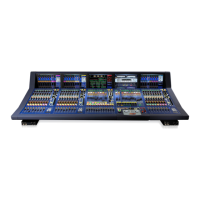314
XL8 Control Centre
Operator Manual
Mute: Function that allows a channel’s signal to
be silenced.
Mute safe: Function that means a mute cannot
be controlled by scene recall or auto mutes.
nm: Symbol for nanometre (one billionth of a
metre).
O/B: Abbreviation for “outside broadcast”.
Oct: Abbreviation for “octave”.
Octave: A difference in pitch where one tone
has a frequency that is double or half of the
frequency of another tone.
ohm (Ω): Unit of electrical resistance.
OS: Abbreviation for “operating system”.
Out of phase: 1. A signal, being similar to
another in amplitude, frequency and wave
shape, but offset in time by part of a cycle.
2. 180° out of phase or having opposite polarity.
See Phase.
Outboard: External, as in an “external device”.
Outboard equipment: External equipment
used with the XL8 Control Centre, but that is not
part of it.
Output: 1. The signal put out by a device.
2. The physical location of where a device sends
out a signal.
Output bay: Control area for main and master
outputs.
Output channel strip: Area on the mix bay
that allows detailed adjustments to a single
channel’s audio parameters.
Output fast strip: One of eight dual-channel
strips in the output fast zone for detailed control
of the matrix mix masters.
Output fast zone: Area on the output bay
containing the matrix mix, and stereo and mono
masters.
Overload: A condition where the signal level is
too high.
PAN: Abbreviation for “panoramic”.
Panning: The left/right positioning of a signal
across a stereo image.
Parameter: A setting whose value can be
altered by the user.
Parametric: A type of EQ that allows all of the
parameters of equalisation to be changed,
including centre frequency, boost/cut in gain,
and bandwidth.
Patch: A temporary connection (physical or
virtual) made between two audio devices or
inside one.
PCB: Abbreviation for “printed circuit board”.
PFL: Abbreviation for “pre-fade listen”.
Phantom power: The power required for the
operation of a condenser microphone when it is
not supplied by internal batteries or a separate
power supply. This is supplied by the XL8
Control Centre itself.
Phase: A measurement (in degrees) of the time
difference between two waveforms.
Point scene: Subdivision of a scene; see
Scene.
Pointer: Marking on a control knob that, when
used in conjunction with the ident around edge
of control knob, helps to indicate the setting.
Post-: The point for accessing audio just after it
leaves a specific channel component, for
example, “post-fader”, where the audio is
tapped from just after it leaves the channel’s
main level control.
POP: Abbreviation for “population”.
POP group:
A number of channels assigned to
a group that has unfold and area B controls.
Provides an easy and quick method of
manipulating and controlling the numerous
channels available on the XL8 Control Centre.
POP group select button: A user-configurable
button for assigning and recalling POP group
members.
Pre-: The point for accessing audio just before it
reaches a specific module, for example,
“pre-EQ”, where the audio is tapped from just
before it gets to a channel strip’s EQ.
Primary navigation zone: Area in the output
bay for output and mix bay GUI screen
navigation and control, and also fast access to
GUI menu options.
PSU: Abbreviation for “power supply unit”.
Psychoacoustics: The study of the perception
of sound, that is, how we listen, our
psychological responses and the physiological
effects on the human nervous system.
Pschycoacoustic noise: Noise that affects the
physiology of the listener.
Quick access button: Button for quickly
selecting its associated strip section.
Return: Auxiliary return or aux return. An
extra input used for receiving a signal from the
output of an internal or external effect
processor. See Bus.
Reverb: An effect where the ambience of a
physical space is simulated. This is done by
copying a signal and replaying at regular

